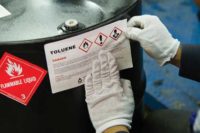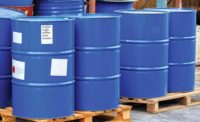Many employers use in-plant labeling such as the Hazardous Materials Information System (HMIS®) and the National Fire Protection Association (NFPA®) 704 Hazard Rating systems. HazCom 1994 allowed employers flexibility regarding the use of in-house labeling systems, and OSHA retained that flexibility in the revised HCS.
NFPA and HMIS labeling will still be allowed for workplace containers, but they must be consistent with the revised HCS. That is, there can be no conflicting hazard warnings or pictograms. This does not mean that the rating systems for HMIS and the NFPA are in conflict with OSHA.
We know that HMIS and NFPA use a “4” for most hazardous and the GHS classification uses a Category “1” to express the most hazardous. But these category numbers will not appear on the label, only on the data sheet, so there should not be any confusion. OSHA says only that employers using NFPA or HMIS labeling must train employees on both the in-house system used and on the GHS-style labels.
May we print labels with pictograms having black borders?
OSHA states that pictograms consist of a red square frame set at a point with a black hazard symbol on a white background, sufficiently wide to be clearly visible. However, in OSHA Brief BR-3636 2/2013, the agency clarified that on in-plant labels a black border can be used, rather than a red border.
How should we label small containers?
OSHA tells us that there are no labeling exemptions for small containers. Workers can receive required information in ways other than simply attaching labels directly to each small container, but OSHA doesn’t provide any additional guidance. A Letter Of Interpretation dated May 5, 1987 says “Hazard warnings used as part of in-plant labeling systems . . . are deemed to be effective when they promote safe handling and use of hazardous chemicals in the workplace.” OSHA says it will examine individual cases of small container labeling to make sure that the information is associated with the proper containers, and that it is complete.
Are blank diamonds allowed on labels?
Some employers have asked about using pre-printed label stock with multiple red diamonds on them. The end user would then print a label using only as many red diamonds as called for by the product’s chemical classification. This could lead to one or more empty red diamonds on a label.
OSHA is not opposed to the use of pre-printed stock, but it does require that all red borders printed on the label have a symbol printed inside it. Allowing blank red diamonds may lead workers to believe that some information is missing.
OSHA says that “blacking-out” unused red diamonds “is compliant with the requirements of the HCS 2012 because it is not a “square red frame set at a point without a hazard symbol.”. . . Be advised that if a blank red frame is not fully covered and filled in, the label would not be in compliance . . . downstream users may inquire whether the blacking-out was done deliberately . . . or whether the label has been defaced . . . .”
Can a shipped container also include an HMIS label?
OSHA says yes, so long as the ratings on the HMIS label do not contradict or cast doubt on the validity of label information required by Appendix C.3.1 of the HCS 2012 (C.3.1) or impede the user's ability to identify the information required by Appendix C.3.2.
Are any other symbols or graphics allowed on in-house labels?
Employers may use additional instructional symbols not included in the HCS label requirements. An example of an instructional pictogram is a person with goggles, denoting that goggles must be worn while handling that chemical.
Do containers already in the workplace require updated labels to comply with HazCom 2012?
By June 1, 2016 all containers in the workplace are to be labeled in accordance with the standard. According to OSHA “The phase-in period for the revisions to the HCS provides adequate time for firms to deplete products in inventory that are not labeled with GHS-compliant labels and to replace workplace containers or signs/permanent labels (such as regulated area signs) in the course of the normal cycle for wear-and-tear replacement.”
All containers shipped after December 1, 2015, will have to be appropriately labeled. This should provide employers with enough time to make sure all containers are properly labeled.
What does OSHA consider “supplemental information?”
On shipped containers, OSHA allows additional instructions or information that the label producer deems helpful as “supplemental information.” Any “hazards not otherwise classified” will be listed under this portion of the label. This section must also identify the percentage of ingredient(s) of unknown acute toxicity when it is present in a concentration of ≥1% (and the classification is not based on testing the mixture as a whole).
Supplementary information can include letters or pictograms indicating necessary personal protective equipment (PPE) needed to safely handle the chemical. Other supplementary information may include directions of use, expiration date, or fill date.
How will HazCom labeling affect DOT labels?
OSHA pictograms do not replace the diamond shaped labels that the DOT requires. Those labels must be on the external part of a shipped container and must meet the DOT requirements set forth in 49 CFR 172, Subpart E. If a label has a DOT transport pictogram, Appendix C.2.3.3 states that the corresponding HCS pictogram shall not appear.
However, DOT does not view the HCS pictogram as a conflict and for some international trade, both pictograms may need to be present on the label. OSHA intends to revise C.2.3.3. In the meantime it will allow both DOT and HCS pictograms for the same hazard on a label.



